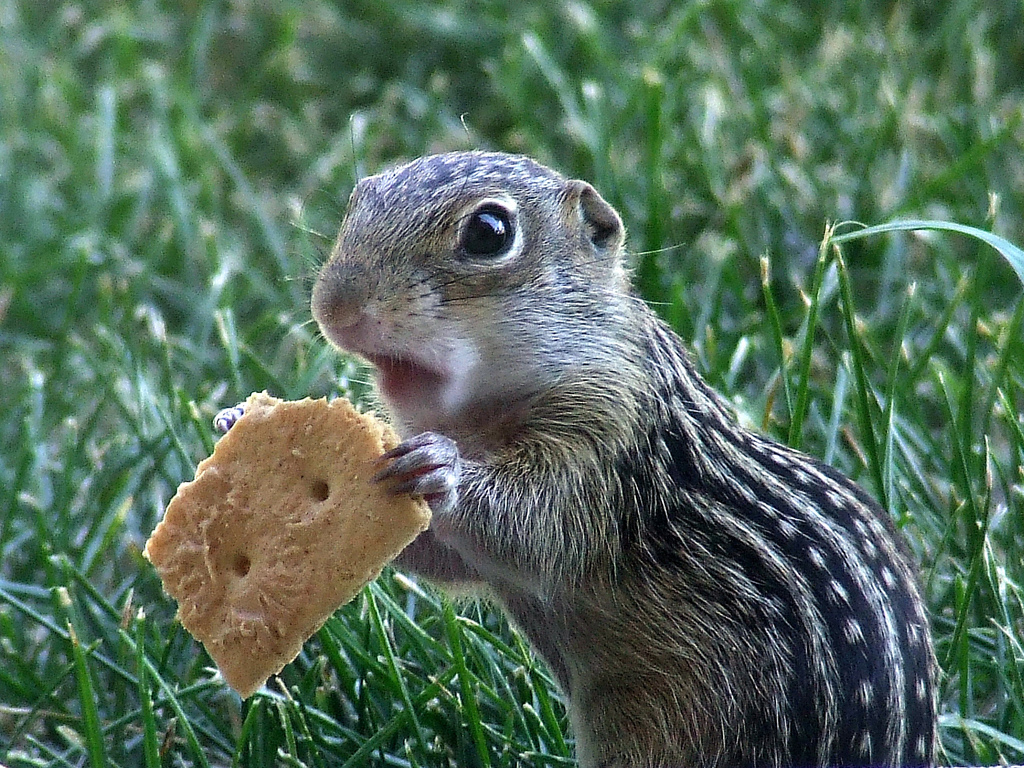One sunny day in mid-October, we watched a little critter sitting up in the yard inspecting its domain. When it noticed us, it scurried through the grass to disappear under a washed-out section of the sidewalk. It was about eight inches long not counting its two and a half-inch tail, and sported black and tan alternating stripes running from head to tail. It had big eyes, little ears, and carried its tail low as it ran. A close inspection would have revealed that the black stripes had little tan dots along their midlines. This little guy wasn’t waiting around for a close inspection, though, He disappeared almost instantly. “There goes a squinny,” Bryan said.
I first heard the term squinny from my boys, while we were living in the Des Moines area. They had caught one and learned its name from a neighbor kid. The jury is out regarding the origin of the term squinny for these little rodents. It seems to be local to central Iowa, and it refers to the thirteen-line ground squirrel, Ictidomys tridecemlineatus.
Outside the Des Moines area, the early settlers called them gophers. In Minnesota, an 1857 cartoon ridiculing the legislature for wanting to spend lots of money on railroads depicted a train being pulled by these “gophers.” This earned Minnesota the nickname the Gopher State. Turning ridicule into state pride, Minnesotans made Goldie the Golden Gopher the mascot for the University of Minnesota’s football team.
But what is Goldie actually, and who is living underneath that sidewalk? It’s not a gopher at all. It’s a 13-line ground squirrel. Its name draws a good image of it.
The 13 lines refer to the 13 stripes on its back, seven broad black stripes alternating with six narrower tan stripes. The stripes or lines are parallel to the backbone. The black stripes have little dots in them. This coloration makes good camouflage in their native short-grass habitats.
The ground part of their name comes from the fact that they live on the ground, not in trees, and in fact they live under the ground in extensive burrows that they’ve excavated by digging with their hind legs. They dig shallow, dead-end burrows when they’re foraging as bolt holes to escape predators like hawks, weasels and snakes. They dig deeper burrows where they will nest and raise their litters of young, and they dig burrows below the frost line, some 20 to 40 inches deep, where they will build a nest and stash food. In November or so, they plug the entrance to the hibernation burrow, curl up in a ball, and hibernate through the winter months just like a bear.
And finally, the squirrel part of their name refers to the fact that they are a kind of squirrel, relatives of the more visible chipmunks and tree squirrels. As squirrels, they eat seeds, leaves and grass as well as insects and other small prey. As hibernators, they fatten themselves up in the fall by doubling their food intake. They gain nearly half again their body weight in fat to get them through the long dark winter. They’ll emerge in March to start the mating, breeding, and young-rearing cycle for the year. A litter of up to eight pups is born a month later, and the female nurses them until they disperse. She may have a second litter after that.
Their ancestors lived in the short grass prairies of the western plains, eating grasshoppers, caterpillars, and other insects along with seeds, flowers and grass. As tall-grass prairies, forests and woodlands have been converted to pastures, lawns and golf courses, they have moved east. they’ll be happy in any short grass environment, like the yard or the garden. They leave a 50-cent-piece-sized hole without dirt around it where they enter their burrows. Because they come out during the day, they, like our little friend, can be seen sitting up on their hind legs inspecting their domains. They are often considered pests when they’re caught at this in the garden. They come out in the day to find food, some of which they stash in their cheeks and carry back down to their nests. They cache it for snacking during these long winter months when, like bears, they wake up periodically to ask if it’s spring yet. We’ll be asking that question, too, come January.
Feature photo from Wikimedia.org by Jared. Alt text: Chomp. Thirteen line ground squirrel scores a graham cracker.

2 comments
My favorite critter! Not relevant to the main findings of the post, but the genus part of their scientific name was changed to ‘Ictidomys’ from ‘Spermophilus’ in 2009 as part of a massive revision of the relatedness of all the ground squirrels – only the European ground squirrels got to keep ‘Spermophilus’ and all the North American ground squirrels got new genus names.
Oops–wouldn’t want to call an American ground squirrel by a European name! Thanks for the correction. Editing is indicated.